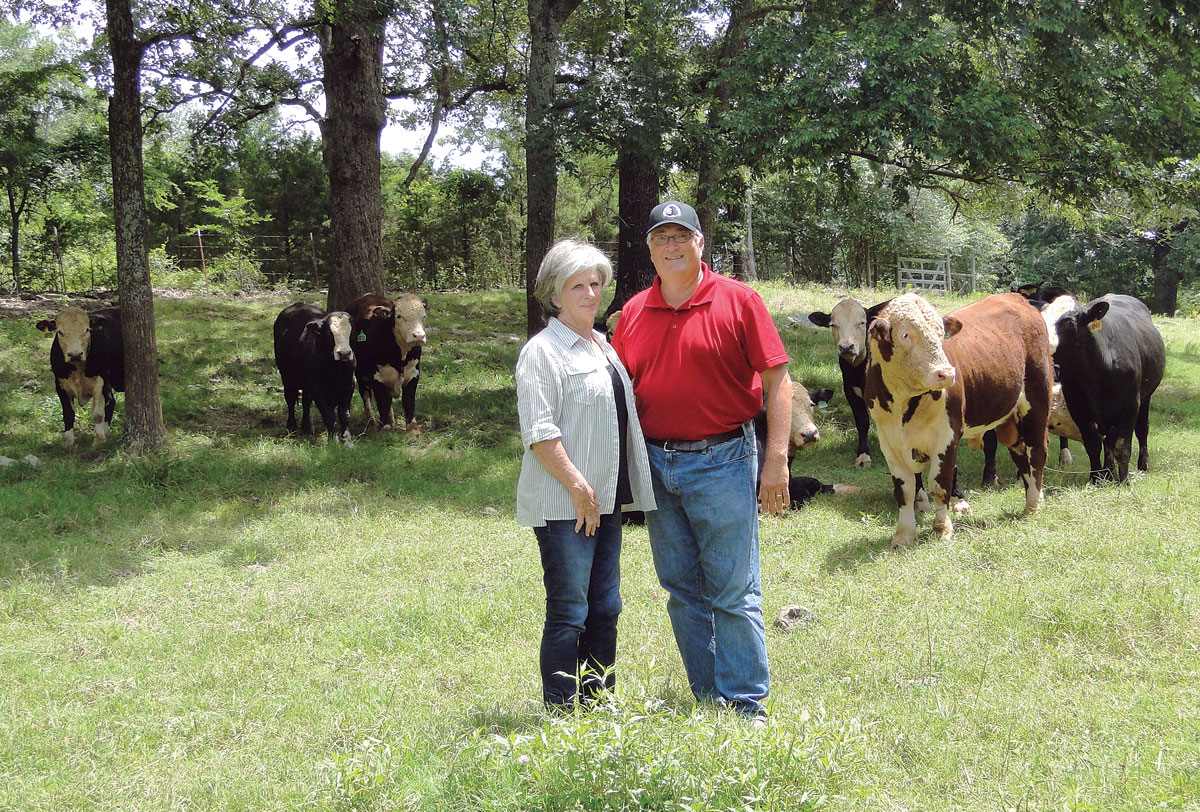
Earlene and Richard Boone built a seedstock operation from the ground up
One day therapist Earlene was in her office when her future husband, city-raised Richard Boone, came in and said she was the kind of woman he would like to date. One of their first dates was to her farm where he arrived in golf shoes, short-sleeved shirt and shorts. Her plan was to fertilize her extensively landscaped yard.
“He wasn’t clean when he went home, but he passed the test,” Earlene said with a laugh.
The couple married in 2000 and live on a farm Earlene inherited from her father, Wallace Earl. After serving in the Navy, Wallace started a dairy in California but didn’t like it, so he and his wife Stella returned to Arkansas where Wallace began a beef cattle herd while his wife worked in a factory.
“My dad worked on the farm and I was his shirttail until I became part-time help because he always said he’d rather pay me because I did a better job,” explained Earlene.
Like so many farm children, Earlene was driving a tractor from a very young age and remembers being in grade school when she jumped on the tractor. The power takeoff caught her dress and ripped it off, but that did not deter the little girl who was haying by the time she was 12.
Richard worked in hospital administration, and the couple’s plan of living happily ever after on the farm took a serious hit when Richard’s job took him to both Florida and Tennessee. Earlene had the entire farm responsibility but also had a good support network that helped whenever she called, which was as infrequently as possible. Richard visits home were sometimes as far apart as two months.
Regardless, the couple improved the farm to prepare for their retirement and to make it easier and safer. Some of the many improvements were adding two new corrals with one containing scales because Richard is a numbers man; four ponds with a gravity fed water system, shutters on outbuildings to collect water, a low-water bridge to improve access to some fields and metal cross fencing. Earlene cut all the pipe with a hacksaw and painted it herself though she hired a welder.
The couple’s herd started with 18 bred registered Hereford cows bred to a black Brangus bull. Immediately upon arrival from Kansas, the cows jumped the neighbor’s fence. Although accustomed to horses and dogs, they finally responded to their herding by walking. The next bull was a polled Hereford chosen because polled is dominant over the cows’ horned gene. After supplementing their herd with 16 pureblood but unregistered Herefords, they went to purchase a red Hereford bull and came back with both the red one and an additional black one because Richard knew black calves sold for more money.
The current herd consists of 85 mommas: 30 registered Black Herefords, 30 registered polled Herefords and commercial animals. The cows are serviced by a Hereford bull whose father was the 2012 world champion and a Black Hereford bull that is the dominant of the pair.
The couple now sells breeding stock, some commercial and some registered. Because Earlene prefers selling off the farm, 70 percent of their sales are by private treaty with the remaining culls and extra calves going to the Stilwell or Fort Smith sale barns. The Boones currently have 15 penned bulls. Since the regular herd bulls are 2,300 pounds, they sometimes use one of their young bulls on first time heifers who are usually 2 years old when bred.
“Our life is really enjoyable. The people we sell to share photos of the animals and often return to buy more. We recently sold a heifer for showing with the ironic name of Cover Girl. We look forward to seeing how well she does,” said Richard.
One of the goals of the Mountain Fork Hereford Farm is producing 70-pound calves. Though the red bull typically produces 70-pounds calve, 100-pound calves arrive occasionally while the black Hereford bull consistently produces at target weight. An interesting side note is that Richard and Earlene strive to reach a new calf before it is an hour old so they can use a simple birth weight system. They measure the hoof and use a heifer or bull chart to supply a surprisingly accurate birth weight.
Good quality nutrition is critical in producing high quality animals. As a result, the Boones develop a 14-percent protein four-way mix based upon recommendations from veterinarian Dr. David Ford and their co-op experts who then produce the ration.
Depending upon weather conditions, young bulls receive 10 pounds of the ration a day, breeding bulls receive 7 pounds, cows get 2 to 3 pounds, weaned calves 4 pounds, bred cows or heifers 1 to 2 pounds and new mommas 4 to 5 pounds daily to encourage milk production and to conserve forage on their limited acreage.
Knowing full well they make money from their feeding regimen, Richard teased Earlene, “We feed them way too much. I have to admit, though, the bred cows and heifers have to get some because they get jealous when they see us feeding their buddies.”
The Boones have a 30-acre hayfield comprised of clover and Johnsongrass, with the first cutting being mostly clover and the remainder mostly Johnsongrass. Pastures contain Bermuda, ryegrass, Bahia and some fescue. Land is fertilized with a 17-17-17 commercial fertilizer and spot sprayed for weeds.
The quality of the Mountain Fork Hereford Farm caught the attention of Farm Bureau who named them the 2019 Crawford County Family of the Year.
“Day-to-day farming can be a motivation rather than an obstacle. While it’s not easy, health issues like my cancer and open heart surgery can be made easier by continuing to meet the needs of the farm and animals as much as possible,” Earlene said. “Soon after the heart surgery, we had triplet bull calves which was a real thrill.”






